Posted by Elena del Valle on June 12, 2015
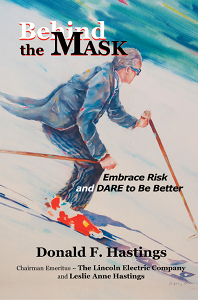
Behind the Mask
Photos: Xlibris Publishing
Before retiring Donald F. Hastings led international conglomerate The Lincoln Electric Company out of a severe financial crisis into record sales and profits. He is convinced his success is due to unexpected strategies of sharing the risk, respect and wealth with all employees.
In Behind the Mask: Embrace Risk and Dare to Be Better (Xlibris Publishing, ) a 207-page softcover memoir penned by his daughter Leslie Anne Hastings, he discusses his career path, shares his opinions about good management strategies, and challenges the modern views of corporate America. They wrote the book for “anyone who is struggling with a person or situation in his/her life that seems insurmountable. There is always a solution.”
“I may be David goading Goliath, but I believe layoffs, in general, are a sign of catastrophic failure on the part of management,” Hastings said in a press release. “To please Wall Street, we are dehumanizing business to a point that is unconscionable. It’s lazy and it’s bad business. I believe human beings are the single greatest resource a company has,” Hastings said. “Of course there’s a risk in taking care of your people, but being creative and taking risks is what inspired management is all about!”
When asked what the biggest surprise from the publication of the book was Leslie Anne said by email, “That the book was so well received on so many levels. Most people read the book in one sitting! Everyone who reads it takes away something different- from ideas and philosophy to courage and humor. It’s a really fun read!”
Before retiring Donald F. Hastings led international conglomerate The Lincoln Electric Company out of a severe financial crisis into record sales and profits. He is convinced his success is due to unexpected strategies of sharing the risk, respect and wealth with all employees.

Donald and Leslie Anne Hastings, authors, Behind the Mask
According to his biography, Hastings, chairman emeritus, The Lincoln Electric Company, was dubbed the Silver-Tongued Mesmerist by his customers. Leslie Anne Hastings, a graduate of Stanford University, was the voice Behind the Mask.
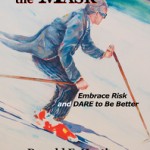
Click to buy Behind the Mask
Comments:
Filed Under: Books
Posted by Elena del Valle on June 4, 2015
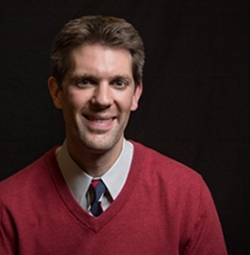
Temple Northup, Ph.D., assistant professor, University of Houston
Photo: University of Houston
Two academics who studied the effects of media in the United States and Austria believe longterm exposure to news may influence racial bias. The results of their three studies were recently published in a 20-page article titled Effects of Long-Term Exposure to News Stereotypes on Implicit and Explicit Attitudes in the International Journal of Communication.
Temple Northup, assistant professor at the University of Houston’s Jack J. Valenti School of Communication, conducted the United States portion of the study while Florian Arendt at the University of Munich in Germany conducted the research in Austria. The study in the United States focused on possible bias toward African-Americans while the two studies in Austria addressed possible bias against foreigners. The researchers believe the influence of television news was likely greater than print news among study participants.
“The two countries were selected due to access of available data for a comparable news stereotype that exists in both countries,” said Northup in a press release. “In the U.S., a large body of research indicates crime is overrepresented on local television news relative to the actual amount of crime that actually occurs in a community. Previous content analyses conducted by researchers at the University of Michigan and the University of California, Santa Barbara have shown that that African-Americans are overrepresented as criminals on local television news when compared to their actual crime rates. In Austria, research has suggested foreigners are overrepresented as criminals in tabloid-style daily newspapers.”
In the first study in the United States 316 participants completed the Implicit Association Test (IAT), a controversial tool used in psychology to measure hidden bias people may have but are unwilling or unable to report. After completing the IAT, participants answered a question about their explicit (conscious) attitudes towards African-Americans, as well as how many hours of local television news they watch per day.
“The two countries were selected due to access of available data for a comparable news stereotype that exists in both countries,” said Northup. “In the U.S., a large body of research indicates crime is overrepresented on local television news relative to the actual amount of crime that actually occurs in a community. Previous content analyses conducted by researchers at the University of Michigan and the University of California, Santa Barbara have shown that that African-Americans are overrepresented as criminals on local television news when compared to their actual crime rates. In Austria, research has suggested foreigners are overrepresented as criminals in tabloid-style daily newspapers.”
There were 489 participants in the first Austria study for which researchers used the same data procedure. Respondents reported how many days per week they read the specific newspaper under investigation. The researchers concluded that exposure to the tabloid-style daily newspaper did not increase the negativity of implicit attitudes. There were 470 participants in the second Austria study. The academics concluded that reading content specifically about crime had a significant effect on implicit attitudes toward foreigners among respondents who said they often read crime articles.
While stereotyping, prejudice, and discrimination are found across the world the impact of media on consumers remains to be clearly defined. The researchers concluded more studies are necessary to better understand the issues “before an earnest attempt to reduce these negative outcomes can be undertaken.”
Posted by Elena del Valle on May 29, 2015

Going for the Gold
Photos: News & Experts
The more debt our country accumulates the more money it needs to pay the bills. The economy has been poor and the government’s solution increasingly has been to print new money with no collateral to back it up, leading many to believe the situation will worsen in the coming years. The deterioration will force our government to offer less to its citizens and charge them more in the form of taxes to pay the accumulated and growing debt, says William A. Storum, J.D., author, Going for the Gold Preserving Wealth, Lowering Taxes (Book Publishers Network, $21.95).
As that happens our currency will loose its worth to inflation; so will other so called hard currencies that have traditionally been considered safe havens, the author says in the book. He believes one way to protect our assets from the devastating losses such shifts would bring is to invest in gold. Given the limited supply of the precious metal many rely on it for the possible proverbial rainy day when the economy collapses and paper money becomes worthless.

William Storum, author, Going for the Gold
Storum points to many examples of economies falling on difficult times and countries with worthless currencies. He illustrates a period in our history in the last century when our government made owning gold by private citizens illegal, forcing people to sell their gold to the government and earning a profit on the difference a year later. He suggests strategies to accumulate gold bullion and invest in gold stocks and instruments in tax smart ways in order to safeguard our savings in case financial disaster strikes.
The 307-page softcover book was published in 2014. The author is an orchardist in California. He has inactive California Bar Association and California Board of Accountancy inactive licenses. There was no contact information on his book website.

Click to buy Going for the Gold
Comments:
Filed Under: Books
Posted by Elena del Valle on May 18, 2015

Alejandro Monteverde, director, Little Boy
Photo: Metanoia Films
A podcast interview with Alejandro Monteverde, director, Little Boy, is available in the Podcast Section of Hispanic Marketing & Public Relations, HispanicMPR.com. During the podcast, he discusses his film Little Boy (see With video New film about believing in the impossible) with Elena del Valle, host of the HispanicMPR.com podcast.
Alejandro is a Mexican writer whose first feature, Bella, won the People’s Choice Award at the Toronto Film Festival, and brought him the American by Choice Award for its positive contribution to Latino art and culture in the United States. His second feature, Little Boy, was picked up for general release by Open Road and had its debut in theaters nationwide April 2015.
Little Boy, produced by his company, Metanoia Films, tells the story of a boy willing to believe the impossible in order to bring his father back from World War II. Alejandro is developing his next film, The Hidden Ones. It is a dark international thriller about a brilliant killer murders the twelve holiest monks on earth and the young FBI agent who dives dangerously deep into the killer’s demonic world. He and his wife Ali Landry, an actress and former Miss USA, live in Los Angeles with their three children.
To listen to the interview, scroll down until you see “Podcast” on the right side, then select “HMPR Alejandro Monteverde” and click on the play button below or download the MP3 file to your iPod or MP3 player to listen on the go, in your car or at home. To download it, click on the arrow of the recording you wish to copy and save it to disk. The podcast will remain listed in the May 2015 section of the podcast archive.
Posted by Elena del Valle on May 13, 2015
By Edward M. Bury, APR
Coordinator of Public Information
Urban Transportation Center at the University of Illinois at Chicago

Edward M. Bury, APR, coordinator, Public Information, Urban Transportation Center University of Illinois at Chicago
Photo: Edward M. Bury
Professionals who work in the public relations industry and members of the news media share this in common: Both sides want to tell a story, and both sides want to deliver fresh, compelling and accurate information.
In late April, I had the privilege to get a first-hand perspective on how public relations professionals and journalists can better work together. How? I moderated a panel discussion, “PR Pros and Journalists Working Together for the Good of the Story.” The noontime event was sponsored by the Chicago chapters of the Hispanic Public Relations Association and the National Association of Hispanic Journalists.
From the media side, the panelists were Stacey Baca, ABC Channel 7 anchor and reporter, and Carly Luque, an assignment editor from CBS Channel 2. The public relations profession was represented by Cristina Alfaro, Director of External Diverse Partnerships at McDonald’s Corporation, and Luis Agostini, Senior Media Executive with Edelman.
Click to read the entire article Both Sides of the Equation: Insight on What’s Good for the Story
Posted by Elena del Valle on May 6, 2015

Jakob Salvati plays Pepper Flynt Busbee in Little Boy
Video and photos: Metanoia Films
In a town of bullies and bully enablers, prejudice and fear, an eight year old boy, who is small for his age, suffers when his father, his best friend, heads off to war. The young boy’s unshakable faith in the return of his father against all odds is at the heart of Little Boy, a lovingly made 106-minute movie set in a Rockwellian United States town during World War II. Little Boy was shot entirely in Mexico and the post production work was done in Los Angeles. It took five years to produce and was completed in 2014. It was released nationwide April 2015. Scroll down to watch a trailer.
The film stars Michael Rapaport, Jakob Salvati, Emily Watson, Ali Landry, and Eduardo Verastegui, and was produced by Mark Burnett, TV and movie producer (Survivor, The Apprentice, Shark Tank, The Bible Series). In the movie, Pepper Flynt Busbee (Jakob Salvati) is willing to do whatever it takes to end World War II because he is convinced that with the end of the war his father will return home. He struggles in his difficult journey and learns several important lessons along the way.

A scene from Little Boy – click to enlarge
Little Boy, with a $20 million budget, was written and directed by Alejandro Monteverde. He also wrote and directed Bella which won the People’s Choice Award at the Toronto Film Festival, and the American by Choice Award for its positive contribution to Latino art and culture in the United States.
Posted by Elena del Valle on May 1, 2015

Photo: BenBella Books, Inc.
Do you prefer to eat vegetarian foods? Did you read The China Study (see Health, nutrition experts examine comprehensive China nutrition study) and Whole (Nutrition expert, educator discuss whole food plant based diet advantages) which outline the healthful advantages of plant based and whole diets? Do you have limited time to cook? If so, The China Study Quick & Easy Cookbook: Cook Once, Eat All Week with Whole Food, Plant-Based Recipes (BenBella Books, $19.95) by Del Sroufe may appeal to you.
The 253-page trade paperback book, edited by Leanne Campbell, PhD and published this year, is chock full of color photos by Robert Metzger in varied sizes. It is divided into sections by type of dish: Breakfast Dishes; Sauces, Salad Dressings & Seasonings; Snacks & Spreads; Salads; Sandwiches; Pasta & Baked Dishes; Soups; Entrees; and Desserts.
A short Appendix has Measurement Guide, Dietary Symbols and Nutritional Value information. At the end of the book there is an offer to sign up for a free digital copy (in Kindle, PDF or ePub) of BenBella’s Best of Plant Based Eating. All that was necessary to receive a copy was to provide a name and email address and verify the email address after receiving a confirmation email from the publisher.
Sroufe is also author of New York Times bestselling Forks Over Knives: The Cookbook, and Better Than Vegan. Campbell is author of The China Study Cookbook.

Click to buy The China Study Quick & Easy Cookbook
Comments:
Filed Under: Books
Posted by Elena del Valle on April 22, 2015

Click to enlarge
Image: No More
According to No More 12.7 million people are physically abused, raped or stalked in one year. Believing there is a strong and compelling need to better understand how these issues impact Latinos, and that Casa de Esperanza is the leading Latino organization in the country dealing with the issues of domestic violence and sexual assault, No More and Casa de Esperanza National Latino Network approached the Avon Foundation for Women to fund a survey on the subject.
Although they declined to disclose the cost, they believe it is the largest and most comprehensive study of domestic violence and sexual assault in the United States Latino community. The results were released this week in the No Mas Study: Domestic Violence and Sexual Assault in the U.S. Latino Community.
More than half of the Latino respondents, (56 percent) said they know a victim of domestic violence and 28 percent said they know a victim of sexual assault. Among survey takers, 41 percent said they believe that fear of deportation is the main barrier preventing Latino victims from seeking help; 39 percent said they thought the fear of more violence and 39 percent said they thought the fear of children being taken away were the top barriers for victims.
According to the survey, parents who responded are much more likely than parents in the United States population at large to talk to their children about domestic violence and sexual assault. More than half (54 percent) of respondents said they have talked to their children, while only 29 percent of parents in the population at large responding to a 2013 No More study said they had talked to their children about those issues.
The survey results have led the organizations to conclude Latino respondents were addressing domestic violence and sexual assault issues since 61 percent of them who said they knew a victim of either also said they intervened and did something for the victim. Lake Research Partners designed and administered a telephone survey of 800 adult Latinos nationwide conducted between January 27 and February 10, 2015. Among those surveyed 30 percent were interviewed in Spanish. The margin of error for the total sample is +/- 3.5 percent.
National Latino Network for Healthy Families and Communities is a project of Casa de Esperanza, a national institute on domestic violence in Latino communities. Casa de Esperanza has worked for 30 years to mobilize Latino communy to end domestic violence. According to the No More website, No More it is a collaboration of many groups working through a fiscal sponsor, the Joyful Heart Foundation, a registered 501c3. The organization’s goald is to raise awareness nationally and bring people, organizations and advocates together “to help gradually shift perceptions, normalize conversations and engage bystanders to take action to prevent and ultimately end domestic violence and sexual assault.”
The Avon Foundation for Women is one of the world’s largest corporate-affiliated philanthropy organizations “focused on issues that matter most to women.” Through 2014, Avon global philanthropy, led by the Avon Foundation, has contributed nearly $1 billion in over 50 countries. Today, Avon philanthropy focuses on funding breast cancer research and advancing access to quality care through the Avon Breast Cancer Crusade, and efforts to reduce domestic and gender violence through its Speak Out Against Domestic Violence program.
Posted by Elena del Valle on April 17, 2015
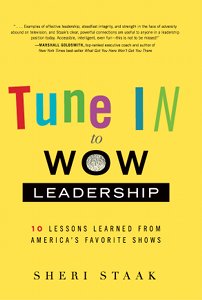
Tune in to Wow Leadership
Photos: Smith Publicity
Depending on their program preferences would be leaders and existing leaders who watch certain entertaining programs on television can accomplish two tasks at once, according to Sheri Staak. The sales executive, teacher and author of Tune In to Wow Leadership: 10 Lessons Learned From America’s Favorite Shows (Greenleaf Book Group Press, $24.95) believes larger than life fictional TV characters from well known programs such as House, The Office, The Simpsons and Dallas offer leadership lessons.
In her 225-page softcover book published January 2015 she highlights examples of fictional leaders from current and past shows to illustrate leadership concepts. She believes some “…TV characters can serve as role models…” She strives to help readers define their own leadership experiences through real world insights and fictional TV show character examples and comparisons.
Staak defines Wow leaders (in contrast to Dud leaders) as those who are confident, fearlessness, have positive energy, are bold decision makers and motivate others. She also says they are honest, trustworthy, humble, respectful, authentic, visionaries, goal oriented, seeking self improvement, good communicators, care about others, and are agents of change.
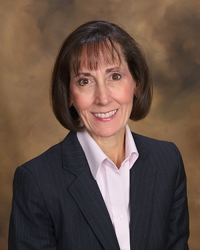
Sheri Staak, author, Tune in to Wow Leadership
“If you’re trying to instill motivation, deliver a call to action, or drive home a point, you must keep your platform skills sharp by preparing in advance–it can make or break your message,” said Staak in promotional materials for her book. “To be a Wow leader, you must have an acceptable level of platform skills. Your job is to inspire, motivate, and communicate effectively in order to lead effectively. Those to whom you present your ideas, directives, and visions are the same people you depend on to step up and push through barriers and challenges.”
Staak, a Chicago resident, has worked with and managed 1,000 sales executives while in working in leadership positions at large privately held and publicly traded global companies. According to her biography she has led businesses with more than $1 billion in revenue, worked with successful start ups and managed business turnarounds.
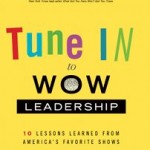
Click to buy Tune In to Wow Leadership
Comments:
Filed Under: Books
Posted by Elena del Valle on April 10, 2015
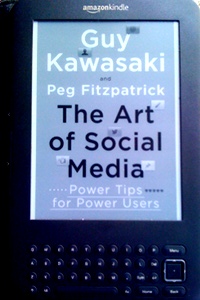
The Art of Social Media digital book first page
Photo: HispanicMPR
Using four or five words that explain what you are about and posting a simple photo that can blow up to a large size is best; as is picking a name that makes it obvious who you are. Try to create a profile that makes you seem competent, likable and trustworthy, says Guy Kawasaki, a believer in the business value of social media, about how business people should build their social media bio and avatar.
In his latest book The Art of Social Media: Power Tips for Power Users (Penguin, $12.99), written with Peg Fitzpatrick, he also says that everyone has a Facebook account, and that people have no choice when it comes to their business but to have a Google+ and a Facebook page. While he discourages paying for followers or likes and asking for shares he says it is fine to pay for Facebook promotions of posts and pages.
In particular, he and his coauthor discuss the ideas and methods they have tried. He recommends a vanity URL, implying that not having one “impugns your intellectual prowess.” Planning in social media is about finding a way to make money, success is measured by reshares of a post, and everyone wants more followers whether they admit it or not, he says in the book. To illustrate tips and suggestions he uses examples from his own businesses like Alltop and Holy Kaw as well as client projects for Motorola, Canva, and Audi he and Fitzpatrick worked on. An example of a project they both were hired for was a Motorola product launch in Latin America. A disclosure accompanies the tips in those cases.
The book is peppered with hyperlinks. The final chapter was dedicated to List of Apps and Service. The book describes social media channels as follows: Twitter for perception, LinkedIn for self promotion, Google+ for passion, Facebook to connect with others, and Pineterest for photos. Kawasaki had 6.4 million followers on Google+ in the summer of 2014, he says in the book. As of this writing he has 1.45 million followers on Twitter and followed 105,000 thousand. Fitzpatrick had 40,300 followers and followed 24,200 people on the same platform.
Kawasaki does work for Canva, an online, graphics design service. He is trustee of the Wikimedia Foundation, and executive fellow at the Haas School of Business at U.C. Berkeley. According to Fitzpatrick’s website she is an author, speaker and social media marketing pro.
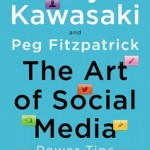
Click to buy The Art of Social Media
Comments:
Filed Under: Books




























